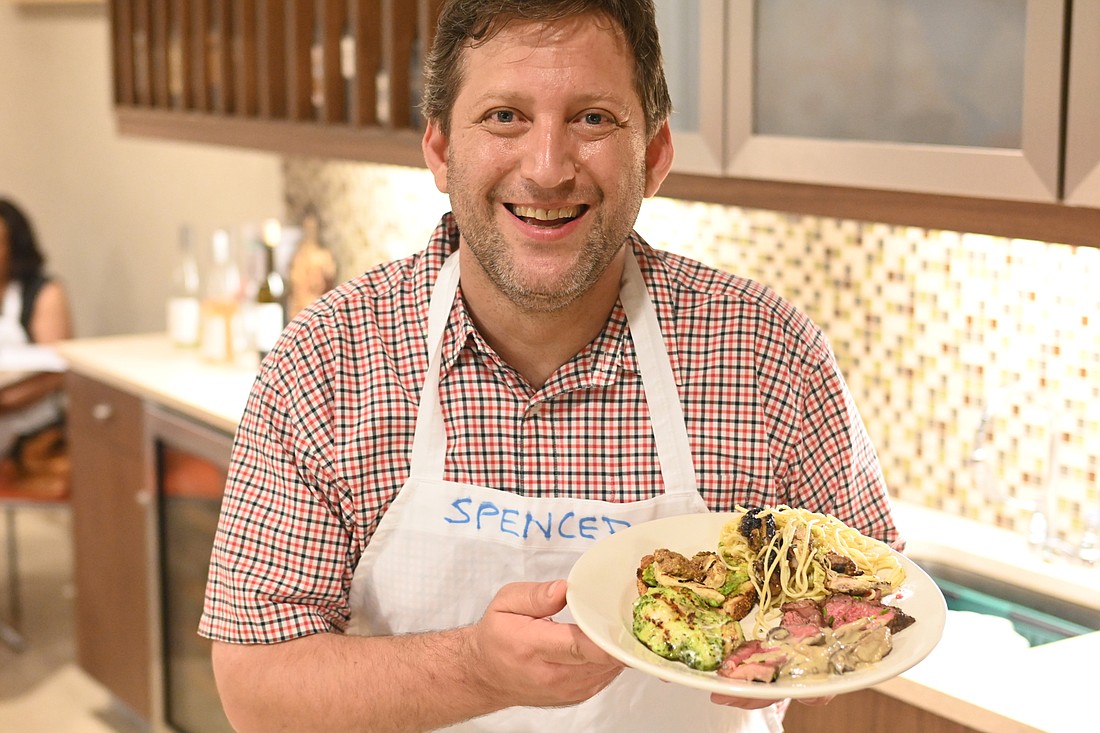- November 22, 2024
-
-
Loading

Loading

I confess. I'm the one who burnt the bread during a recent Publix cooking class.
But in my defense, those two pieces weren't charred beyond recognition.
They were lovingly blackened.
This reporter, an admitted amateur in the kitchen, recently had the bright idea of enrolling in a cooking class and getting his hands dirty at the art of making a meal. So I contacted Publix about the possibility of attending their grilling course and told them I was a beginning chef, and they said each of their hands-on courses were suitable for newbies.
I showed up to the Publix location on University Parkway after a long work day, and Senior Managing Chef Jim Hendry greeted me and the rest of the class. He sat us down and gave us an overview of what we'd be doing that day, introduced us to his colleague Chef Michael McClure and then immediately deputized us as apprentice sous chefs.
The hands-on courses are limited to 12 people, which means that not everybody will get a turn at the grill.
But Hendry and McClure took turns running us through the prep work and the actual placing of food on fire.
Hendry told everybody to be careful with the knives because they're sharp, and he showed us where we would be taking dirty dishes when we were through with them. And then he gave us a talk about tasting things.
"We're going to be using some tasting spoons; We'll have some tasting opportunities along the way," said Hendry. "There's two rules with the tasting spoons. They're single-use; no double-dipping. And then they go directly into the garbage can."
With that tip about tasting decorum out of the way, we started to assume our work stations. The kitchen was oriented to both Hendry and McClure; we would begin preparing one dish on one side of the kitchen, and then we'd move to listen to the other chef's instructions. And we'd be preparing a great many dishes with a great many ingredients.
Mostly, that meant the less sexy work of preparing marinades. We stripped parsley and we chopped garlic and shallots for the olive tapenade, and we combined anchovies, arugula, cheese and vinegar for a chicken marinade. We chopped onions and garlic for a fish marinade, and we prepared a cheesy gorgonzola mushroom topping for our steaks.
McClure, preparing the steaks, gave us instructions for how to cook them perfectly at home using a meat thermometer.
"Sometimes, you touch a steak and you don't really know what's going on in the middle," he said. "This is your key, guys: Cooking it to temperature. It's 100 or 125 degrees for medium rare, bring it up to 135 or 140 degrees for medium."
McClure cautioned that it isn't an exact science, and he said one of the most important parts of cooking a steak is removing it from the heat source. You want to sear it, but you also want to let it rest.
"Always let your meat rest before you slice it because that's going to keep all the juices from just pouring right out," he said. "Then you wind up with a big pool on your cutting board and your meat's dry. When you let it rest, it often comes up five to ten degrees. If you are going for a specific temperature, remember, it's going to still cook while it's resting."
We had time, not only to taste the things we had just made, but also to move back to the next cooking station. The steak was resting while we worked on the fish, and Hendry gave a demonstration on how to cut the fish. Earlier, he had shown us how to properly chop vegetables by gripping the bottom of the knife securely and letting the heel do most of the work.
Time on the grill was a coveted resource; one of my classmates got to grill the steaks, and another classmate was assigned the task of grilling the chicken. Yet another classmate would handle the fish, and one got to grill halloumi cheese.
But who did they tap to grill the bread for our avocado toast? This guy.
I wish I could tell you that I was smooth behind the grill, that I seamlessly morphed into Emeril Lagasse.
But that would be a lie.
Armed with tongs, I spread the toast out over the grilling surface. The grill could fit about a dozen of them. And then I started waiting. I investigated whether the pieces on the edges of the grill had cooked. And they hadn't.
Then I looked at the pieces on the grill's hot spot. Holy cow! That side is already charred!
That happened twice; and we threw away both burnt pieces. But then I got the rhythm. I had some other brief coordination problems on the grill; I dropped one perfectly cooked piece of toast onto a vacant burner by accident and fished it out.
By the time I had cooked all of the toast for our dish, my classmates were giving me side-eye.
But they gleefully cheered when I served the last piece of toast and surrendered the tongs.
And I considered that a victory.
Soon, we were sitting down and sampling all that we had made. It was a full meal with grilled chicken and truffle-accented pasta, herb-marinated grilled fish, a perfect grilled ribeye steak and a grilled cheese avocado toast.
We knew exactly what went into cooking it, because we had prepared it with our own hands. We had walked into the Publix kitchen as strangers, but we left with a full belly, a doggy bag and most importantly a sense of fulfillment.